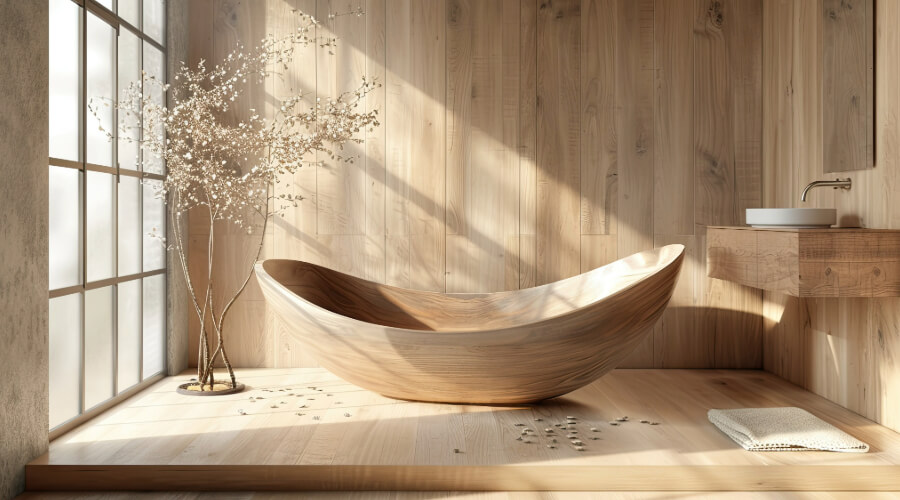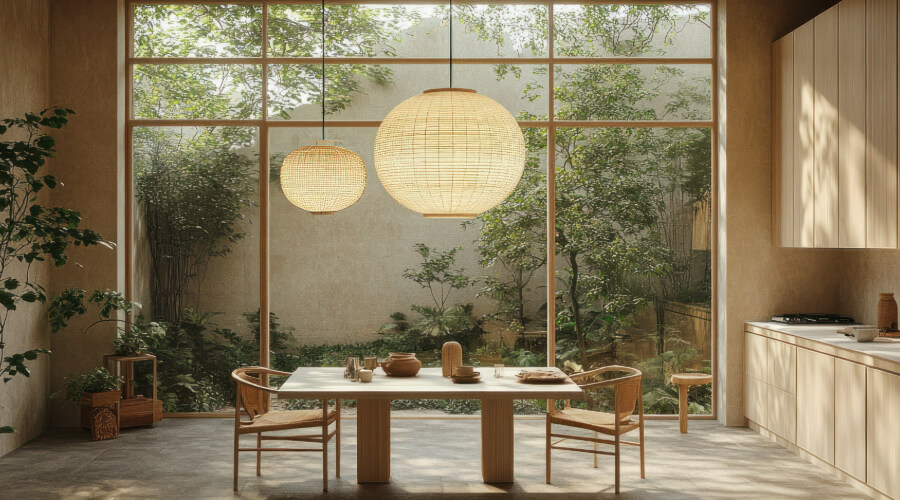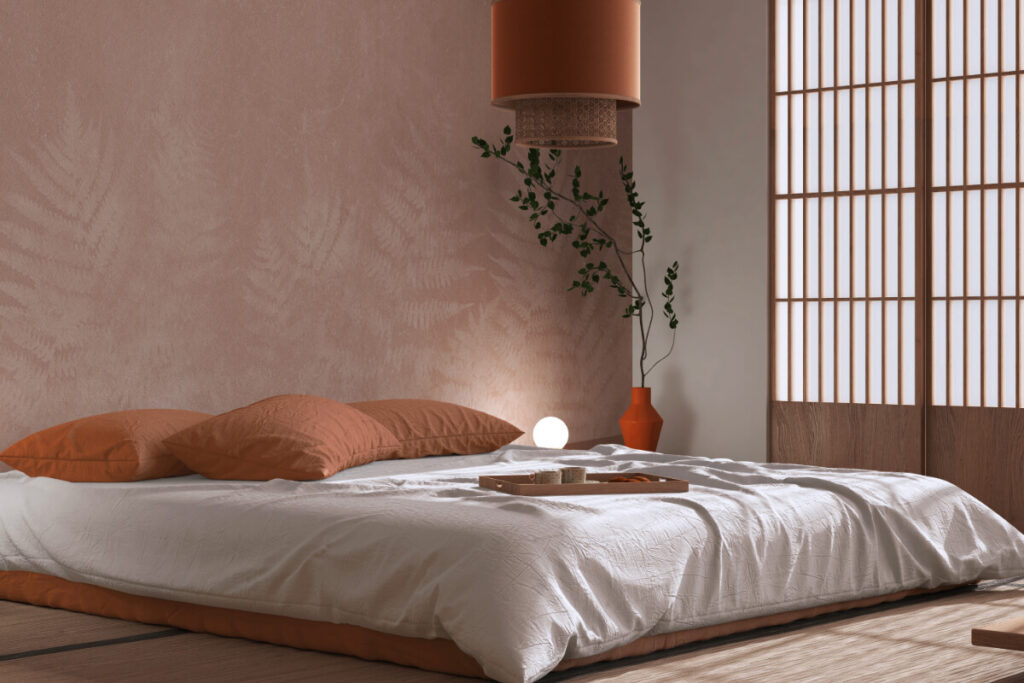When we return home exhausted after work, we seek not only rest but inner peace. Today, one of the most popular interior styles promises exactly that – spaces that breathe simplicity yet radiate warmth. The Japandi style, combining Japanese minimalism with Scandinavian functionality, creates homes that become true sanctuaries for modern people.
This design approach merges Eastern and Western philosophies, interweaving Japanese minimalism with Scandinavian functionality to create living spaces that speak to something deeper than aesthetics alone. Behind this seemingly simple style lies a profound understanding of how our environment affects our wellbeing and daily rhythm.
The Philosophy Behind the Beauty
At the heart of Japandi lie two ancient concepts: the Danish hygge, celebrating cosiness and contentment, and the Japanese wabi-sabi, which finds profound beauty in imperfection and transience. These philosophies might seem worlds apart, yet they share surprising common ground when brought together under the Japandi umbrella.
The reason why Scandinavian and Japanese design marry so well is because both are rooted in functionality and simplicity, though there are nuanced differences between the styles. While Scandinavian interiors typically embrace cooler tones with crisp white walls, Japanese design gravitates toward warmer, natural colours. This fusion creates a balanced aesthetic that feels both sophisticated and approachable.

The Art of Intentional Living
In Japandi interior design, minimalism is more than a design aesthetic; it’s a philosophy that informs every decision, from the layout of the space to the choice of materials and colours. This approach encourages us to rethink our relationship with our surroundings, prioritising spaces that nurture and inspire rather than overwhelm.
The perfect fusion of Japanese and Scandinavian design focuses on aesthetically pleasing and highly functional minimalist designs, with the biggest focus being to stay with subtleness. Every item chosen serves a purpose either functionally or aesthetically, often both. This thoughtful curation leads to spaces that feel open, airy, and profoundly tranquil.
Materials That Tell Stories
Without a doubt, wood is the key element here, preferably in one and the same type of wood, but you can combine slightly lighter wood with darker types. Then add hints of other natural materials such as wool, linen, bamboo, rattan, ceramics and glass. The beauty of Japandi lies in its celebration of natural materials that age gracefully and offer a tactile experience.
Instead of synthetic materials, opt for wool, linen, and cotton in muted earthy tones. A chunky knit throw on a linen-upholstered sofa evokes hygge’s warmth, while subtle fabric irregularities celebrate wabi-sabi’s imperfection. These materials don’t just look beautiful – they feel authentic and connect us to the natural world, creating spaces that ground us in an increasingly digital age.
The Power of Purposeful Colour
Neutral earthy palette includes clay reds, warm beiges, muted greys, and soft whites – colours that soothe rather than shout. The Japandi colour scheme is largely based on the Scandinavian preference for cooler tones but is balanced with warmer, earthy colours that pick up the Japanese influences.
The simplicity of a mostly monochromatic palette is key, with the advice of selecting one lead colour and one accent colour and not expanding beyond those two hues. This restrained approach to colour creates visual harmony and allows the natural beauty of materials and forms to take centre stage.

Light as Life Force
Hygge prioritises warm, glowing illumination, while wabi-sabi embraces natural shadows and subtle gradients of light. In Japandi interiors, lighting becomes an art form that shifts beautifully throughout the day. Multiple light sources at different heights create an inviting atmosphere, combining Japanese paper lanterns with Scandinavian candle arrangements for an intimate yet airy effect.
Natural light plays a crucial role in Japandi design, serving as a bridge between the indoor space and the natural world. Incorporating large windows and reflecting sunlight off bright white walls are key techniques used to invite light into the home. This connection between interior and exterior spaces reinforces the style’s deep respect for nature.
Furniture That Grounds Us
For a Japandi-style home, you should invest in lower furniture: a sofa, stool or coffee table that are almost directly on the floor. The furniture should be constructed from clean lines to achieve a sophisticated, pared back look. This preference for low-profile furniture isn’t merely aesthetic – it creates a sense of connection to the earth that inspires peace and serenity.
Japandi design is focused on craftsmanship, looking for pieces that will work with your decor and stand the test of time. It’s a clear antidote to the present disposable culture, instead focusing on pieces that are sustainable and safe for our planet. Each piece of furniture becomes an investment in both beauty and sustainability.
The Green Touch of Nature
Plants are a big part of Japandi home design. Large potted plants or small bonsai trees create a calm atmosphere, while natural light connects indoor and outdoor spaces. Whether it’s a simple foraged branch, fresh or dried flowers, or lush greenery, incorporating plants aligns with Japandi’s emphasis on connection to nature.
Plants and flowers bring warmth, cheer, and a splash of colour to a minimalist interior, even if it’s just a few stems. These living elements soften the clean lines and add that crucial touch of imperfection that makes a space feel human and lived-in.
Japandi represents more than a design trend – it’s a movement towards more mindful, sustainable living. By merging the minimalist aesthetics of Japanese and Scandinavian design, Japandi creates spaces that are as functional as they are beautiful, transforming minimalism into a lifestyle. In our fast-paced world, this style offers a refuge where we can slow down, breathe deeply, and reconnect with what truly matters.
As we move deeper into 2025, Japandi offers more than just a trend – it invites us to slow down and live with intention, creating spaces that feel like a gentle exhale after a long day. Whether you’re looking to overhaul your entire home or simply incorporate elements of this philosophy into your living space, Japandi provides a blueprint for a more balanced, intentional way of living that nurtures both body and soul.



